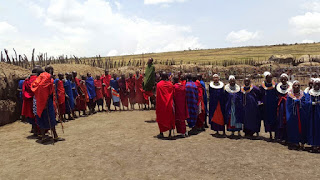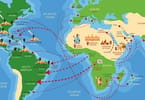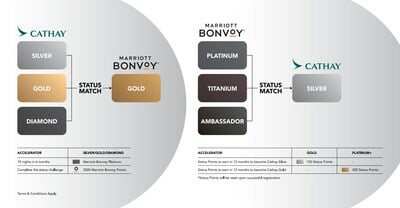TANZANIA (eTN) – Thousands of American viewers on Tuesday morning this week watched a thrilling live broadcast of the wildlife movement in Tanzania’s famous Ngorongoro Crater through an amazing journey by news anchor Amy Robach who reported live from Africa’s most-known wildlife Eden. The program added a thrust to Tanzania on the world tourism map and gave its tourism the much-needed shot to showcase its wildlife and safari richness.
Through ABC News’ “Good Morning America,” Robach was inside Ngorongoro where she took American viewers on an immersive tour of Tanzania’s Ngorongoro Crater and among the beautiful sites and exotic animals which live in harmony with humans, the Maasai cattle herders.
Viewers of ABC News joined Robach from tens of thousands of miles away in the middle of the African continent to watch the live broadcast of natural wonders inside the Ngorongoro Crater where she mixed with wild animals and the nomadic Maasai cattle herders.
Good Morning America is part of the popular ABC channel and is said to be the most-watched television program in the US, Australia, and other parts of the world with a subscription.
The ABC News station beamed live, pictures of the wildlife in Ngorongoro crater in what it termed “The first network television event to be simultaneously broadcast live in 360°.”
The Good Morning America program aired or televised live the Natural Wonders of the Ngorongoro Crater between 0700 and 0900 hours in the US Eastern Time Zone, similar to mid-afternoon in Tanzania and East Africa, a difference of 8 hours ahead.
Good Morning America had teamed up with IM360, the leader in immersive and interactive content solutions, to launch “GMA on Safari.”
The program brought virtual reality to a global audience via live network broadcasts, with online access provided through websites and apps.
Viewers of the program observed off-road video shots of a stunning landscapes and wildlife that make the Ngorongoro Conservation Area and its Crater, one of the world’s natural wonders.
Robach also reported on the encroaching threat of poachers to Tanzania and Africa’s majestic animals, though Ngorongoro Crater and the entire conservation area are free from poachers. It is a place where wild animals roam freely with little threat from poachers.
Good Morning America was the world’s first live broadcast to bring to television screens the uncensored pictures of nature at its best. ABC said this is the first time on network television that VR cameras and gear had allowed viewers to pick their adventure live and in real time.
Viewers from across United States observed a never-before-seen virtual reality and drone content filmed in the Ngorongoro Conservation Area and neighboring Serengeti National Park, a safari mecca populated by the biggest of big game of the African continent: the lion, leopard, buffalo, rhino, and elephant.
The Good Morning America program exposed the Ngorongoro Conservation Area and its famous crater to the magnitude of American travelers looking to visit Tanzania, hence, admire the natural beauty and wonder as it beamed live to millions of people in the US and other parts of the world.
Ngorongoro Conservation Area in northern Tanzania stands as a model example of the place in the world where local communities are fully involved in tourism development, sharing the land and tourist resources with conservation custodians.
Covering 8,292 square kilometers of wildlife conserved and a cattle grazing area, the Ngorongoro Conservation Area is the only place in Tanzania where guns are not needed to protect the much-hunted elephants, rhinos, and other wild species.
Best known as “Africa’s Garden of Eden,” Ngorongoro is a homeland for Maasai pastoralists and is one of the most-visited wildlife parks in Tanzania, attracting 647,817 tourists each year.
Some 87,000 people, mostly the Maasai pastoralists, live inside the conservation area, taking care of livestock as their economic activity.
But the increase of population and need for more pastures has attracted the conservation authority to involve the Maasai communities to establish cultural tourist sites in their localities as a means to raise their incomes directly through tourist gains.
Through benefit-sharing initiatives, the conservation area stands a good example of a place on this planet where natural foes – humans and wild animals – are living as permanent friends.
Standing as a good model of wildlife conservation for the benefits of tourism in Africa, Ngorongoro Conservation Area has shown a way to other nature-protected areas on the African continent. Travel philanthropy and humanitarian support in the area stand as case studies to be emulated in other wildlife parks in Africa.
Through these collaborative initiatives, Tanzania and the rest of Africa could manage to stop conflicts and create a peaceful environment which is conducive for responsible tourism development and wildlife conservation.
Community benefits from tourism development has been crucial for sustainable projects that benefit nations in Africa and raises incomes to communities living in tourist-attractive sites.
Through good neighborliness, poaching of wildlife in the Ngorongoro Conservation Area has ceased, making this famous Tanzanian famous the second in Africa where the endangered and most-hunted black rhinos are found roaming freely, after South African wildlife parks.
Located some160 kilometers west of Tanzania’s northern tourist city of Arusha, Ngorongoro supports the greatest concentration of wildlife left on Earth. It is a multiple land-use system under which Maasai pastoralists share the resources with wildlife, one of the world’s earliest systems to be established in order to reconcile human development and conservation.
Ngorongoro is a unique tourist attractive site in Tanzania and as such it’s an important economic resource to local residents, safari and tour operators, hunting firms, the East African region, and Tanzania.
WHAT TO TAKE AWAY FROM THIS ARTICLE:
- The Good Morning America program exposed the Ngorongoro Conservation Area and its famous crater to the magnitude of American travelers looking to visit Tanzania, hence, admire the natural beauty and wonder as it beamed live to millions of people in the US and other parts of the world.
- The Good Morning America program aired or televised live the Natural Wonders of the Ngorongoro Crater between 0700 and 0900 hours in the US Eastern Time Zone, similar to mid-afternoon in Tanzania and East Africa, a difference of 8 hours ahead.
- Viewers of ABC News joined Robach from tens of thousands of miles away in the middle of the African continent to watch the live broadcast of natural wonders inside the Ngorongoro Crater where she mixed with wild animals and the nomadic Maasai cattle herders.























